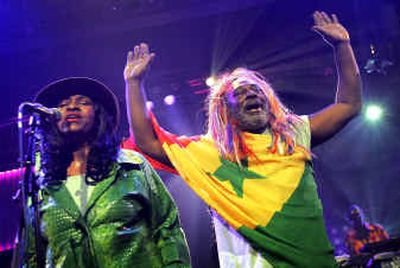Current scene a musical urban blight

In this spring’s media swirl surrounding the “comeback” of Prince, there were rhapsodic accounts of his skills as an entertainer, memory-lane trips through his groundbreaking funk-rock of the early ‘80s.
The loving glance backward was overdue. But at the same time, it was a little sad because it raised a thorny question: Where are Prince’s progeny?
In contemporary popular music, who besides Outkast is galvanizing audiences from that slightly threatening outsider zone once known as the black fringe? Who’s waving the freak flag, keeping George Clinton’s P-Funk audacity alive, challenging the mainstream with Fishbone-style smashups?
“You would think, in the age of Outkast, that there would be a lot of crazy types of innovation going on,” says guitarist Vernon Reid, founder of the ‘80s black alternative-rock band Living Colour.
Instead, there’s a huge vacancy in left field. Declining revenue, allegedly due to file-sharing, has record executives more risk-averse than ever, particularly where a cash cow like urban music is concerned.
The demand for hits is as old as the Victrola. But increasingly, that pressure has caused African American artists aligned with any sort of fringe — musical, social, whatever — to be marginalized by the big labels.
“There’s a vicious amount of anti-intellectualism in our recorded arts,” Reid argues. “Black music was the music everybody came to for emotional truth. That’s what soul was.
“Now, it’s so constructed and artificial. We have singers who, to show their feelings, have to holler all the time. … The track might be hot, but there’s no emotional investment going on underneath it.”
As urban music has assumed a place of commercial pre-eminence, its artistic horizons have been steadily narrowed by a wicked cocktail of assembly-line production aesthetics, fearful executives and audiences that demand gratification within a song’s first 30 seconds.
The black rock franchise is owned by Lenny Kravitz, virtually its only practitioner. Guitarist/songwriter Ben Harper, the nonclassifiable artist who’s most successfully amassed a fringe crowd, sells records but not in Missy Elliott numbers. Within the business, even Outkast is seen not as a shining triumph of creativity but as a high-achieving fluke.
“You have to remember, this is a business,” says Big Jon Platt, a senior talent executive at Virgin Records and EMI Music Publishing.
There’s not an executive “who doesn’t want to find something unique,” he says, “but things aren’t set up the way they were in 1980. These labels are owned by corporations, and they need results.”
Platt, who was involved with introducing talented rapper-producer Kanye West, believes that hip-hop is alternative expression. But many in the genre say the industry maintains a double standard: White alternative rock bands aren’t signed with the mandate that they become instant chart-toppers, but in hip-hop, even the trippiest thinker is expected to connect with the MTV/BET audience.
The Roots have encountered this doublethink on their last three projects. Though the Philadelphia collective is a true band — an anomaly in hip-hop — and its music bears the influence of James Brown and Ornette Coleman, its alternative leanings don’t matter much in the boardroom.
Despite street cred as one of the most forward-thinking collectives in black music, it is pushed to follow a blueprint that’s more Nelly than Hendrix — that is, play the accessibility game, generate singles and videos.
“The labels know that 75 percent of the buyers of black music are white,” says Richard Nichols, the Roots’ manager. “Most of those people have a very specific use for black music: It’s about the beat, it’s for dancing, whatever. They’re not going to it looking for complexity or art. I’d argue that minstrelsy reigns supreme right now.”
For much of pop music’s history, black artists have been not just kings of the dance floor, but art-minded trailblazers. Reid recalls Atlantic Records in the late 1960s, where the roster included jazz visionary Rahsaan Roland Kirk alongside Led Zeppelin.
“It was the will of that corporation to subsidize adventures,” Reid says. “And they did it because they believed that those could lead to greater hits, different ideas getting through.”
He believes that Living Colour — which had several singles, including “Cult of Personality,” and successful albums in the late ‘80s — was lucky: It heeded its instincts and still managed to wrangle some success.
“Things just sort of lined up,” he says. “What we were doing, what Public Enemy was doing, it was bubbling below the radar. Then when it popped out, it happened despite the industry.”